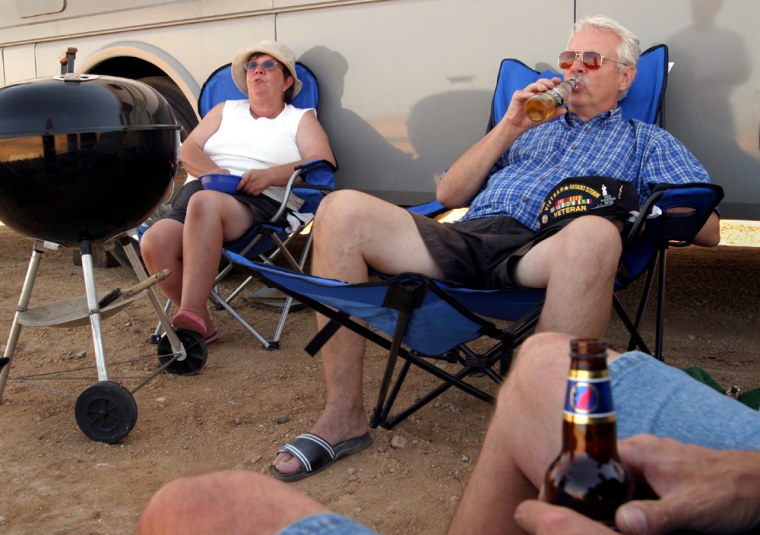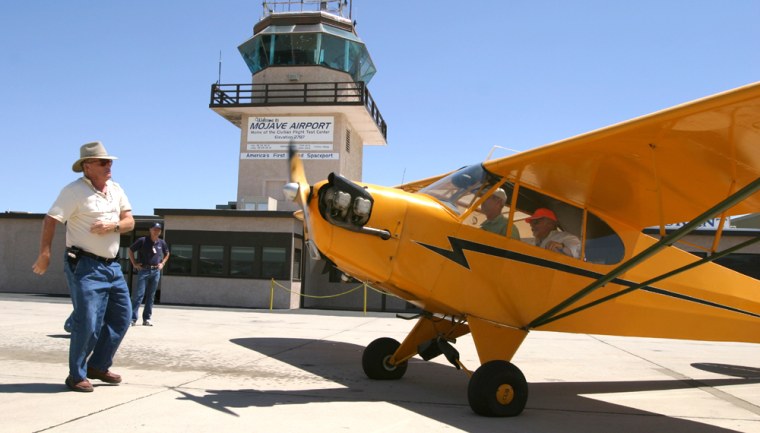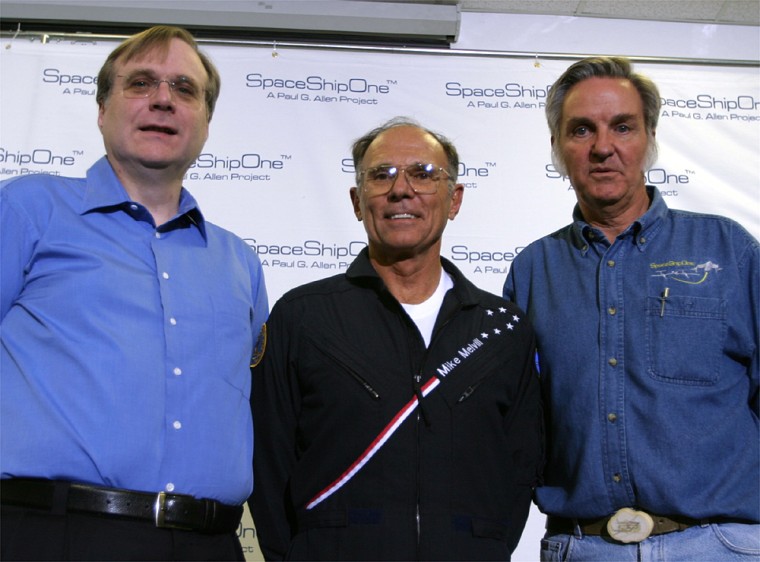The man chosen to become the first private-sector space pilot says he is "ready to go" on a mission that organizers hope will begin a new era in manned spaceflight.
Thousands of spectators converged on this desert town to witness the flight of the SpaceShipOne rocket plane, due to begin at 6:30 a.m. PT (9:30 a.m. ET) Monday. MSNBC.com will provide live streaming-video coverage.
If SpaceShipOne reaches 100 kilometers (62 miles) in altitude, as expected, test pilot Mike Melvill would become the first civilian ever to fly a privately developed craft into space.
After days of suspense, Melvill's selection was announced Sunday by Mojave-based Scaled Composites, the company behind SpaceShipOne's construction. He was picked out of a pool of three test pilots for the flight, which represents a preparatory step toward winning the $10 million X Prize for private spaceflight.
"I'm very, very flattered to be have been chosen for this," the 63-year-old South Africa native said. "Those other two guys were every bit as good as me or better. I just got the luck of the short straw. ... I am ready to go, and we are going to win the X Prize — you can put your money on it."
Melvill, who holds several world aviation records, has flight-tested aircraft ranging from crop dusters to jet fighters. He was at the controls of SpaceShipOne on its previous flight in May, when it reached an altitude of 40 miles. He said he enjoyed the flight in May, and figured Monday's flight to be similar, just a "little higher, a little faster."
One of Melvill's fellow pilots, Pete Siebold, will serve as his backup. The other, Brian Binnie, will pilot the White Knight carrier plane, which brings SpaceShipOne to an altitude of 50,000 feet for a midair launch.
Melvill shared center stage at the Mojave Airport on Sunday with Rutan and the project's billionaire backer, Microsoft co-founder Paul Allen. Rutan beamed with pride as he addressed the overflow crowd of reporters.
"I’ve been to two goat ropings and a county fair but I’ve never seen anything like this. I didn't realize there were this many cameras in Mojave," he said drily. "Are some of you from out of town?"
Rutan said the enthusiasm for the project from the public and media proved that there was "an enormous pent-up hunger to fly in space, and not just dream of it."
Criticizing government-funded space flight as being stuck in the slow lane for decades, Rutan said he hoped Monday's flight would open up a new industry.
"The significance (of the attempt) is the realization that this is for us to do, not just for governments to do."
Rutan said that if governmental space agencies didn't change their ways to keep up with the new breed of private space entrepreneurs, "they will be gazing from the slow lane as we speed into the space age."

Allen — who is listed as the fifth-richest individual on Forbes magazine's annual list, with a net worth of $21 billion — said he has spent "in excess of $20 million" on the project. Rutan paid tribute to Allen, saying his support "allowed us to develop a complete manned space program for the price of one of those government paper studies."
"I'm so proud of that it brings tears to my eyes," Rutan said.
Allen also struck an emotional tone: "Tomorrow we will attempt to add a new page to the aviation history books."
For NASA and the military, going to a 62-mile altitude for a suborbital flight is a throwback to the 1960s. But SpaceShipOne's flight would break a space barrier for private enterprise. From that height, Melvill would experience a few minutes of weightlessness, glimpse the blackness of space above the curving Earth, and earn his astronaut wings.
This flight will be part of Rutan's step-by-step effort to test the rocket plane safely. It won’t qualify for the X Prize, because SpaceShipOne will not be carrying the weight of two passengers, but Rutan's team is expected to try for the prize sometime in the next few months.
'It's the future of outer space'
The prospect of witnessing the first-ever suborbital spaceflight by a privately developed craft has drawn the world’s attention to the Mojave Airport, the site for takeoff and landing.
“The people who are coming in RVs from all over the United States are euphoric,” said Stuart Witt, the airport’s general manager.

In an freshly graded airport parking lot, scores of recreational vehicles and tents were setting up for the night. Fay and Lynn Plank of Eugene, Ore., said they were the first to arrive, pulling in Saturday morning.
“It’s like the Wright Brothers,” Lynn Plank said. “History is being made, and hopefully if it does happen successfully, it’s the future of outer space.”
Her husband, Fay, chimed in: “NASA doesn’t need to have all the front-row seats.”
Rutan took note of the Planks in the news conference Sunday, quoting Lynn Plank's desire for her grandchildren to go to Jupiter as an example of the kind of space dreams that inspired their efforts.
"We all want our children to go to the planets," Rutan said.
The Planks' son, Marcus, persuaded them to take the trip after hearing the news from Scaled Composites. “When they announced there was going to be an attempt, and the public was invited, I figured, well, we’ve got to be there,” he told MSNBC.com. “It gives us hope for where the future lies.”

Sometimes it seemed as though the interviewers outnumbered the interviewees. Marcus’ wife, Sarah, said five groups of journalists visited the family’s mobile home on Saturday. TV crews from Germany and Britain crossed paths at XCOR Aerospace’s hangar on the airport grounds.
XCOR is working on its own suborbital rocket plane, designed to take off and land like a regular airplane from the Mojave Airport. XCOR President Jeff Greason told MSNBC.com that SpaceShipOne’s success would also be a boon to his company.
He said potential investors frequently ask whether this can really be done.
“It’s good to have this barrier broken,” Greason said.
XCOR turned its hangar into a hostel this weekend for some of the spectators who couldn’t find hotel rooms in the Mojave area. One of the company’s founders, Aleta Jackson, is even planning to make breakfast for the guests.
The National Space Society, meanwhile, was planning an overnight party at the RV parking lot, adding to the Woodstock-like atmosphere surrounding the event.
The weekend’s big question focused not so much on whether SpaceShipOne’s attempt would be successful, but on whether thousands, tens of thousands or hundreds of thousands would show up for Monday morning’s launch.
Witt was betting on a turnout of 30,000. He said that would match the attendance for the 1986 landing of the Voyager, another craft designed by Burt Rutan that made the first nonstop round-the-world flight without refueling.
Burt’s brother Dick — who was a pilot on that Voyager flight and is now a test pilot for XCOR — is betting on 100,000.
A free meal is riding on which guess comes closer to the truth, Witt said.
An earlier version of this report mischaracterized Paul Allen's ranking among the world's richest individuals.
